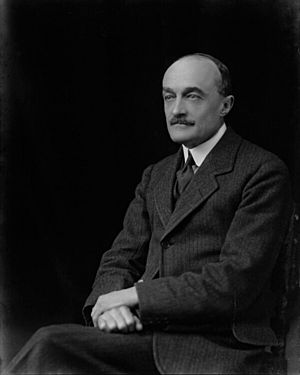Arthur Browne, 8th Marquess of Sligo facts for kids
Quick facts for kids
The Most Honourable Colonel
The Marquess of Sligo
|
|
|---|---|

A c. 1920 photograph of Browne
|
|
| Birth name | Arthur Howe Browne |
| Born | 8 May 1867 |
| Died | 28 May 1951 (aged 84) |
| Allegiance | |
| Rank | Colonel |
| Unit |
|
| Battles/wars | |
| Spouse(s) | Lillian Whiteside Chapman |
Colonel Arthur Howe Browne, who later became the 8th Marquess of Sligo, was an important Irish soldier and nobleman. He was born on May 8, 1867, and lived until May 28, 1951. He was honored with the KBE.
Throughout his life, he was known by different names. Until 1903, he was called Arthur Howe Browne. From 1903 to 1941, he was known as Lord Arthur Browne. He became the Marquess of Sligo later in his life, in 1941.
Arthur Browne's Life and Military Career
Arthur Browne was the third son of Henry Browne, 5th Marquess of Sligo. His mother was Catherine Henrietta Dicken. He attended Windlesham House School from 1877 to 1880. After that, he studied at Clifton College.
In 1903, his father became the Marquess after his older brother passed away. This meant Arthur received the special title of Lord Arthur Browne. Much later, in 1941, Arthur himself became the Marquess. This happened when his nephew, who was the Marquess before him, died at a young age.
Arthur Browne first served as a lieutenant in the local militia. He then did very well in the exams to join the Regular Army. On June 8, 1889, he became a second lieutenant in the Royal Munster Fusiliers. He was promoted to lieutenant on December 30, 1891.
He worked as a transport officer during the Tirah Campaign from 1897 to 1898. After this, he was promoted to captain on August 27, 1898. He also served with his regiment in South Africa during the Second Boer war.
When the war ended in 1902, he traveled with his battalion to India. They sailed from Cape Town to Bombay in September 1902. He was then stationed in Multan in Punjab. He became a major in 1907. During World War I, he served as a Colonel on the staff of the Directorate of Intelligence at the War Office.
From 1919 to 1930, Colonel Browne was a key leader at the Imperial War Graves Commission. This organization helps remember and honor soldiers who died in wars. In 1923, he wrote about how important it was to treat all soldiers fairly. He hoped that in the future, everyone would see that all soldiers, no matter their background, received the same respect and memorials.
A report from 2021 looked back at his words. It noted that while he might have thought he was looking ahead, his views were shaped by common ideas of his time. These ideas sometimes led to different treatment for soldiers from different backgrounds. The report explained that decisions made then were influenced by the way people thought about different groups of people in the British Empire.
Family Life
Lord Sligo married Lillian Whiteside Chapman on November 18, 1910. She was the daughter of Charles Chapman. Lord Sligo passed away in May 1951, at the age of 84. His younger brother, Lord Terence Browne, became the next Marquess.
His nephew, who became the 10th Marquess, described Lord Sligo's funeral. It happened on an election day. His coffin, covered with a Union Jack flag, was carried through the gates into Westport town. The main undertaker was a respected local builder who had been a general in the Old IRA. No one thought the flag was strange or a joke. It was hardly even noticed. The 8th Marquess believed strongly in God, the British Empire, and Westport, in that order. For him, these three things fit together perfectly.

